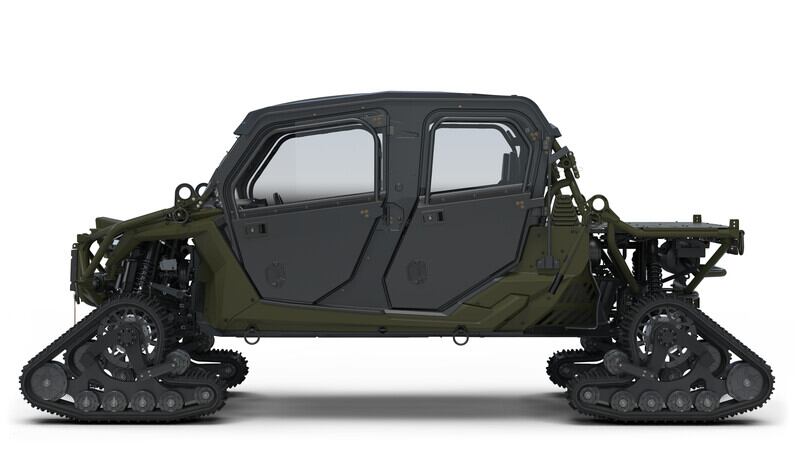WASHINGTON — Polaris has developed a kit to convert the MRZR Alpha — used by U.S. Special Operations Command as its Lightweight All-Terrain Vehicle — for the Arctic and is gearing up to be able to produce it for customers early next year.
The Arctic kit is currently in government validation testing, and a production decision will be made at the start of next year on how many kits the command will buy for its LATV fleet, according to Polaris executives.
Special operations units and all of the U.S. armed services have an interest in boosting their operational capabilities in the Arctic. The Army released a strategy for operating in the region in 2021 and has slowly reviewed what it will need to modernize and build up effective operational units in the Arctic.
Polaris won the contract to supply the MRZR Alpha as the command’s LATV in 2020 for $109 million.
The kit — which Polaris displayed at Modern Day Marine in Washington, D.C., this month — provided tracks instead of wheels, plus a cab that keeps passengers less exposed to the elements, the company said.
“Obviously improving the over-snow capability where a wheeled vehicle is somewhat limited” is a reason customers want this capability, Nick Francis, Polaris’ vice president for government and defense, told Defense News in a recent interview. “But there are other types of transitionary terrain or loose soil conditions that a tracked vehicle can also help with.”
Francis noted the cab system can be used separately, with or without tracks.
“The vehicles are expeditionary in nature,” he said, and “having a single vehicle that can be used for a wide variety of missions is very important. … If you can have one vehicle perform in the desert, and then modify that vehicle quickly within two to three hours, and then have it perform in the Arctic environment, you’re able to do more with one asset, so it greatly reduces the logistics burden, maintenance burden, those types of things.”
The track installation is “pretty straightforward,” said John LaFata, an MRZR engineer with Polaris, as they simply take the place of the wheels and tires through an adapter. There is one additional component that provides anti-rotation features to keep the tracks from over-rotating, he added.
“The cab itself is a bit more work from that side of things because we went down the path of designing a cab that would provide really good protection and sealing capability to those elements, whether it’s an Arctic mobility … and other sorts of environments where you’d like to have some occupant protection from ... dust, debris or other sorts of hazards,” LaFata said. “So it contains a number of components.”
These include a front and rear hard-coat polycarbonate windshield, a roof, and a rear panel. The doors are steel structures with a paintable surface so they can be camouflaged for different environments, according to LaFata.
The doors have additional venting to allow for airflow into the vehicle, and there’s a vent in the rear panel to allow for airflow out of the vehicle. The package also includes a defroster as well as windshield wipers and a spray for clearing debris from the front windshield. The cab also comes with a heating feature through floor vents.
The Arctic kit is an option that U.S. Special Operations Command can exercise as part of the base contract for LATVs. Polaris is now entering its third year of the seven-year contract.
“Polaris and government validation testing is underway on the tracks, and the cab will start very, very shortly,” Francis said. “Typically, the validation process can take anywhere from three to six months depending on weather and different conditions, so we expect we’ll be able to offer production kits, I would say, likely early next year.”
The Arctic kit will be on display at the special operations conference SOFIC in Tampa Bay, Florida, this week, and will make appearances at other trade shows over the course of the year, including the Association of the U.S. Army’s annual conference in Washington in the fall.
Jen Judson is an award-winning journalist covering land warfare for Defense News. She has also worked for Politico and Inside Defense. She holds a Master of Science degree in journalism from Boston University and a Bachelor of Arts degree from Kenyon College.



